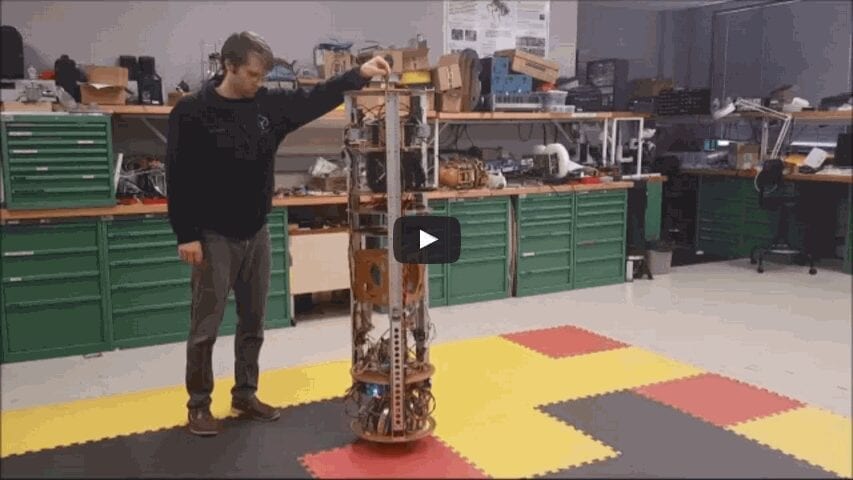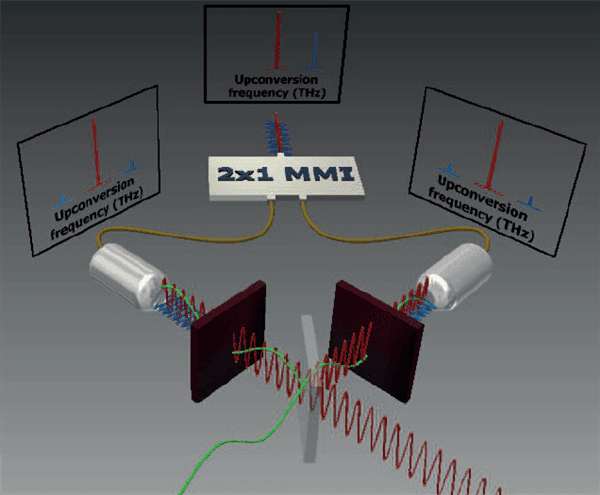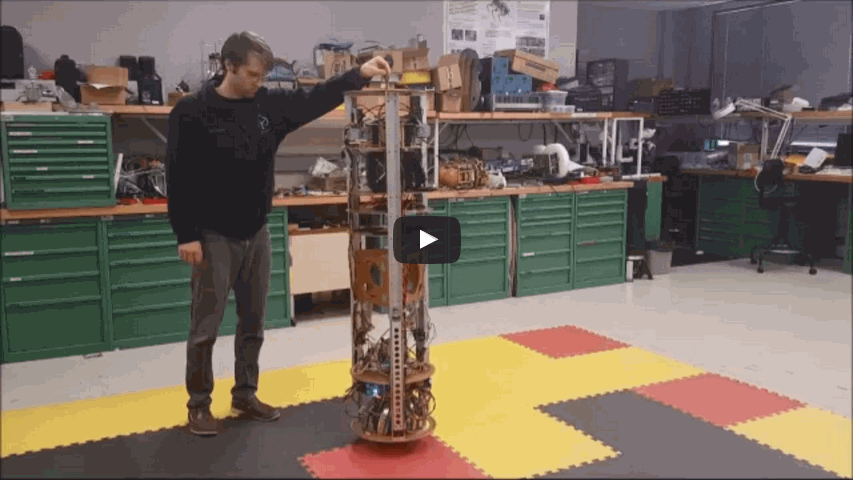
More than a decade ago, Ralph Hollis invented the ballbot, an elegantly simple robot whose tall, thin body glides atop a sphere slightly smaller than a bowling ball. The latest version, called SIMbot, has an equally elegant motor with just one moving part: the ball.
The only other active moving part of the robot is the body itself.
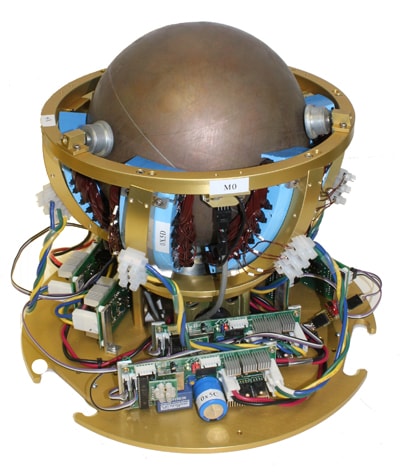
The spherical induction motor eliminates the robot’s mechanical drive system.
The spherical induction motor (SIM) invented by Hollis, a research professor in Carnegie Mellon University’s Robotics Institute, and Masaaki Kumagai, a professor of engineering at Tohoku Gakuin University in Tagajo, Japan, eliminates the mechanical drive systems that each used on previous ballbots. Because of this extreme mechanical simplicity, SIMbot requires less routine maintenance and is less likely to suffer mechanical failures.
The new motor can move the ball in any direction using only electronic controls. These movements keep SIMbot’s body balanced atop the ball.
Early comparisons between SIMbot and a mechanically driven ballbot suggest the new robot is capable of similar speed — about 1.9 meters per second, or the equivalent of a very fast walk — but is not yet as efficient, said Greg Seyfarth, a former member of Hollis’ lab who recently completed his master’s degree in robotics.
Induction motors are nothing new; they use magnetic fields to induce electric current in the motor’s rotor, rather than through an electrical connection. What is new here is that the rotor is spherical and, thanks to some fancy math and advanced software, can move in any combination of three axes, giving it omnidirectional capability. In contrast to other attempts to build a SIM, the design by Hollis and Kumagai enables the ball to turn all the way around, not just move back and forth a few degrees.
Though Hollis said it is too soon to compare the cost of the experimental motor with conventional motors, he said long-range trends favor the technologies at its heart.
“This motor relies on a lot of electronics and software,” he explained. “Electronics and software are getting cheaper. Mechanical systems are not getting cheaper, or at least not as fast as electronics and software are.”
SIMbot’s mechanical simplicity is a significant advance for ballbots, a type of robot that Hollis maintains is ideally suited for working with people in human environments. Because the robot’s body dynamically balances atop the motor’s ball, a ballbot can be as tall as a person, but remain thin enough to move through doorways and in between furniture. This type of robot is inherently compliant, so people can simply push it out of the way when necessary. Ballbots also can perform tasks such as helping a person out of a chair, helping to carry parcels and physically guiding a person.
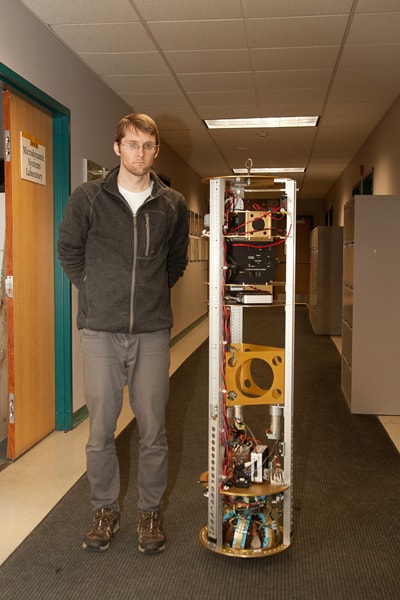
Greg Seyfarth and SIMbot
Until now, moving the ball to maintain the robot’s balance has relied on mechanical means. Hollis’ ballbots, for instance, have used an “inverse mouse ball” method, in which four motors actuate rollers that press against the ball so that it can move in any direction across a floor, while a fifth motor controls the yaw motion of the robot itself.
“But the belts that drive the rollers wear out and need to be replaced,” said Michael Shomin, a Ph.D. student in robotics. “And when the belts are replaced, the system needs to be recalibrated.” He said the new motor’s solid-state system would eliminate that time-consuming process.
The rotor of the spherical induction motor is a precisely machined hollow iron ball with a copper shell. Current is induced in the ball with six laminated steel stators, each with three-phase wire windings. The stators are positioned just next to the ball and are oriented slightly off vertical.
The six stators generate travelling magnetic waves in the ball, causing the ball to move in the direction of the wave. The direction of the magnetic waves can be steered by altering the currents in the stators.
Hollis and Kumagai jointly designed the motor. Ankit Bhatia, a Ph.D. student in robotics, and Olaf Sassnick, a visiting scientist from Salzburg University of Applied Sciences, adapted it for use in ballbots.
Getting rid of the mechanical drive eliminates a lot of the friction of previous ballbot models, but virtually all friction could be eliminated by eventually installing an air bearing, Hollis said. The robot body would then be separated from the motor ball with a cushion of air, rather than passive rollers.
“Even without optimizing the motor’s performance, SIMbot has demonstrated impressive performance,” Hollis said. “We expect SIMbot technology will make ballbots more accessible and more practical for wide adoption.”
Learn more: ON THE BALL: OMNIDIRECTIONAL MOBILE ROBOT HAS JUST TWO MOVING PARTS
The Latest on: Omnidirectional mobile robot
[google_news title=”” keyword=”omnidirectional mobile robot” num_posts=”10″ blurb_length=”0″ show_thumb=”left”]
via Google News
The Latest on: Omnidirectional mobile robot
- Robot dogs armed with AI-aimed rifles undergo US Marines Special Ops evaluationon May 8, 2024 at 12:59 pm
The United States Marine Forces Special Operations Command ( MARSOC) is currently evaluating a new generation of robotic "dogs" developed by Ghost Robotics, with the potential to be equipped with gun ...
- A Roundup of New Robotson May 1, 2024 at 6:16 am
The cups are available in four diameters, from 40 to 100 millimeters, and three mounting configurations (3/8G male or female and 32 millimeter square). All are made from thermoplastic polyurethane for ...
- The Best Robot Vacuums for 2024on April 30, 2024 at 5:00 pm
Robot vacuums are more capable and affordable ... I previously managed the consumer electronics reviews team, and before that I covered mobile, smart home, and wearable technology for PCMag ...
- Video: Ingenious EEWOC robot uses a tape measure to climb quicklyon April 22, 2024 at 4:59 pm
A new wheeled robot is able to climb metal structures ... multiple EEMMMa's that can be extended in different directions for omnidirectional movement. The scientists also envision utilizing ...
- Video: Self-balancing omnidirectional motorcycle spins, slides and glideson April 22, 2024 at 1:59 am
as well as a heap of self-stabilizing robot projects. Indeed, this isn't even his first crack at an omnidirectional motorcycle, having released a video some seven months ago showing how he'd put a ...
- I Played With Disney's Magic HoloTile Floors and AI-Boosted Droidson April 4, 2024 at 7:27 am
Just moments before this clever telekinesis trick, I watched how this floor also works as an omni-directional treadmill ... Disney is testing little waddling robots that wander through Star ...
- Misconceptions About How Warehouse Mobile Robots Work with Humanson November 21, 2023 at 10:46 am
Because so few logistics executives have worked with these systems, there are misconceptions surrounding how warehouse mobile robots work with humans. James Hart, a manager at Lucus Systems ...
- The Future of Human-Robot Interaction Is Mobileon May 31, 2023 at 9:45 pm
Strong makes no claim of great personal strength or extraordinary precision. Three omnidirectional mobile robots perform the heavy lifting and stabilization while Strong gently guides the pipe ...
- Ultra-Mobile Little Robot Will Climb The Wallson September 7, 2020 at 4:43 am
Roving robots generally fall into one locomotion category, and the fanciest are amphibious. We categorize this one as transforming between three modes. The first mode is like an inch-worm and a ...
via Bing News







